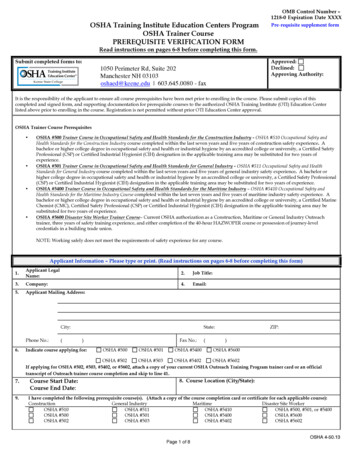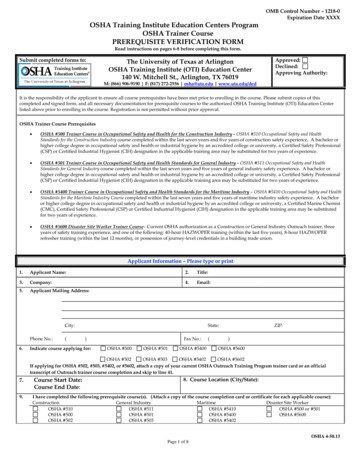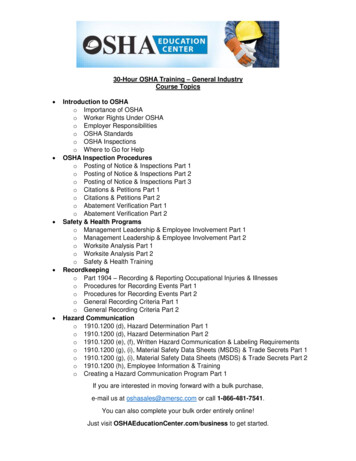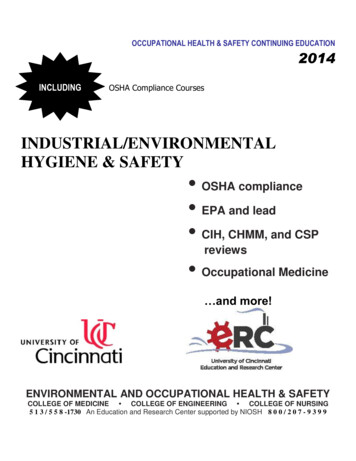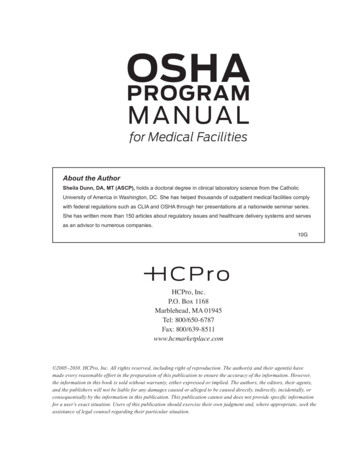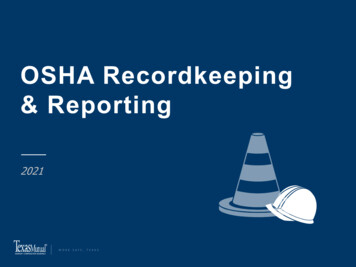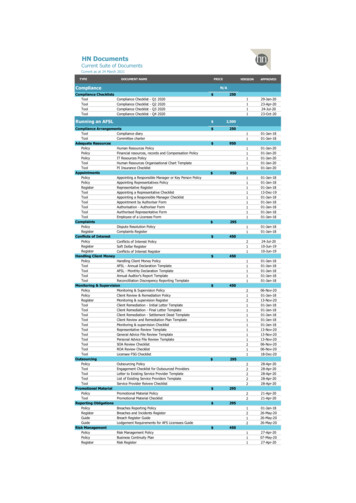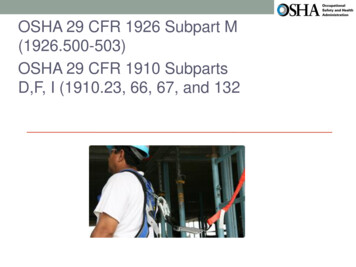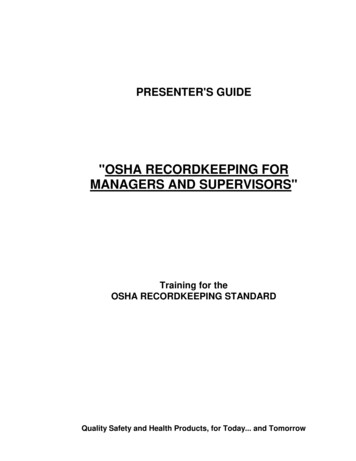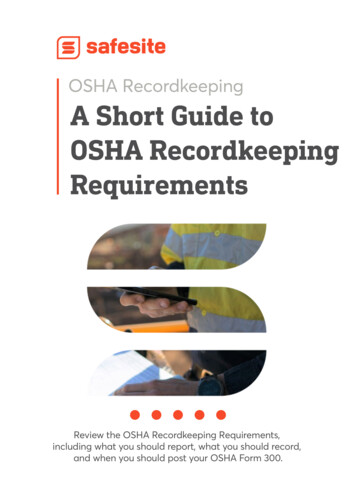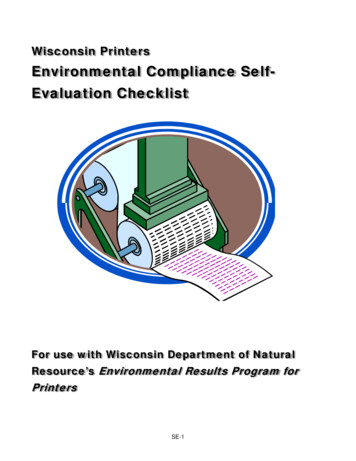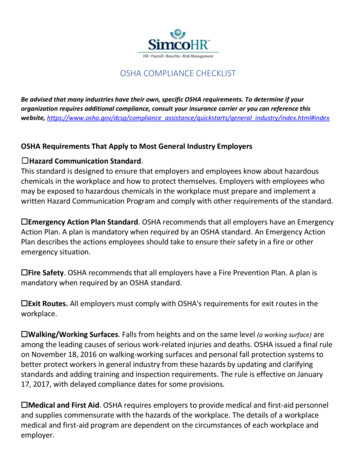
Transcription
OSHA COMPLIANCE CHECKLISTBe advised that many industries have their own, specific OSHA requirements. To determine if yourorganization requires additional compliance, consult your insurance carrier or you can reference thiswebsite, https://www.osha.gov/dcsp/compliance assistance/quickstarts/general industry/index.html#indexOSHA Requirements That Apply to Most General Industry Employers Hazard Communication Standard.This standard is designed to ensure that employers and employees know about hazardouschemicals in the workplace and how to protect themselves. Employers with employees whomay be exposed to hazardous chemicals in the workplace must prepare and implement awritten Hazard Communication Program and comply with other requirements of the standard. Emergency Action Plan Standard. OSHA recommends that all employers have an EmergencyAction Plan. A plan is mandatory when required by an OSHA standard. An Emergency ActionPlan describes the actions employees should take to ensure their safety in a fire or otheremergency situation. Fire Safety. OSHA recommends that all employers have a Fire Prevention Plan. A plan ismandatory when required by an OSHA standard. Exit Routes. All employers must comply with OSHA's requirements for exit routes in theworkplace. Walking/Working Surfaces. Falls from heights and on the same level (a working surface) areamong the leading causes of serious work-related injuries and deaths. OSHA issued a final ruleon November 18, 2016 on walking-working surfaces and personal fall protection systems tobetter protect workers in general industry from these hazards by updating and clarifyingstandards and adding training and inspection requirements. The rule is effective on January17, 2017, with delayed compliance dates for some provisions. Medical and First Aid. OSHA requires employers to provide medical and first-aid personneland supplies commensurate with the hazards of the workplace. The details of a workplacemedical and first-aid program are dependent on the circumstances of each workplace andemployer.
OSHA Requirements That May Apply to Your Workplace If you have employees who operate machinery (e.g., saws, slicers, shears, slitters, power presses,etc.), you may be subject to OSHA's Machine Guarding requirements. If your employees service or maintain machines or equipment that could start upunexpectedly or release hazardous energy, you may be subject toOSHA's Lockout/Tagout requirements. Electrical hazards, such as wiring deficiencies, are one of the hazards most frequently citedby OSHA. OSHA's electrical standards include design requirements for electrical systems andsafety-related work practices. Employers must perform an assessment of each operation in their workplace to determine iftheir employees are required to wear personal protective equipment (PPE). Note thatengineering controls and work practices are the preferred methods for protecting employees.OSHA generally considers PPE to be the least desirable means of controlling employeeexposure. If necessary to protect the health of your employees, you must provideappropriate respirators. You must establish a Respiratory Protection program that meets therequirements of OSHA's Respiratory Protection standard. Employers whose employees are exposed to excessive noise (e.g., conditions that make normalconversation difficult) may be required to implement a Hearing Conservation program. Employers should evaluate their workplaces for the presence of confined spaces. If employees may be exposed to blood or bodily fluids as part of their assigned duties, youmay be subject to OSHA's Bloodborne Pathogens standard. If your employees operate Powered Industrial Trucks (i.e., forklifts), you may be subject toOSHA's Powered Industrial Trucks standard. Review materials related to the standard's operator training requirements, includingsample daily checklists and an outline of a sample training program**This list is not comprehensive - additional OSHA standards may apply to your workplace. Be sure to reviewOSHA's general industry standards (29 CFR 1910) for other requirements. In addition, section 5(a)(1) of theOccupational Safety and Health Act, known as the General Duty Clause, requires employers to provide theiremployees with a workplace that is free of recognized hazards likely to cause death or serious physical harm.**
Survey Your Workplace for Additional HazardsSurvey your workplace for additional hazards and OSHA requirements by: Using a checklist. See the Self-Inspection Checklists in OSHA's Small Business Handbook.OSHA Publication 2209 (2005). Using an online tool. OSHA eTool: OSHA Hazard Awareness Advisor. This tool can help youidentify and understand common safety and health hazards in your workplace. It will ask youabout activities, practices, material, equipment, and policies at your workplace. The HazardAwareness Advisor uses your answers to determine the hazards that are likely to be present. Itthen prepares a customized report that briefly describes the likely hazards and the OSHAstandards that address those hazards. Using OSHA's Hazard identification Training Tool. This is a game-based training tool for smallbusiness owners and workers interested in learning the core concepts of hazard identification.After using this tool, users will better understand the process to identify hazards in their ownworkplace. Reviewing OSHA's Safety and Health Information BulletinsDevelop a Comprehensive Jobsite Safety and Health Program While OSHA does not require employers to develop comprehensive safety and healthprograms, development and implementation of these programs is an effective way to complywith OSHA standards and prevent workplace injuries and illnesses. The information you'veobtained from the steps above is a good start for developing a comprehensive safety andhealth program.Recordkeeping, Reporting and Posting Recordkeeping. OSHA requires certain employers to keep records of workplace injuries andillnesses (29 CFR 1904).First determine if you are exempt from the routine recordkeeping requirements. You are notrequired to keep OSHA injury and illness records (unless asked to do so in writing by OSHA or theBureau of Labor Statistics) if:1) you had 10 or fewer employees during all of the last calendar year (29 CFR 1904.1); or2) you are in certain low-hazard industries (29 CFR Part 1904, Subpart B, Appendix A).NOTE: As of January 1, 2015, OSHA updated the list of industries that are partially exemptfrom keeping OSHA injury and illness records. See Updates to OSHA's Recordkeeping Rule.
If you do not qualify for these exemptions, you must comply with OSHA's recordkeepingrequirements.Download OSHA's recordkeeping forms or order them from the OSHA Publications Office.Read the regulations. 29 CFR 1904 Reporting Fatalities and Severe Injuries. All employers, regardless of size or industry, mustreport to OSHA all work-related fatalities within 8 hours. All employers must also report toOSHA all work-related inpatient hospitalizations, all amputations, and all loses of an eye within24 hours.Read the regulations. 29 CFR 1904.39Learn more. OSHA's Recordkeeping Rule. Electronic Submission of Injury and Illness Data. An OSHA rule requires certain employers toelectronically submit certain injury and illness data through OSHA's Injury Tracking Application(ITA).Learn more. OSHA Final Rule to Improve Tracking of Workplace Injuries and Illnesses OSHA Poster. All employers must post the OSHA Poster (or state plan equivalent) in aprominent location in the workplace. Download or order the OSHA Poster in English orSpanish, and other languages. Access to Employee Exposure and Medical Records. An OSHA standard (29 CFR 1910.1020)requires employers to provide employees, their designated representatives, and OSHA withaccess to employee exposure and medical records. Employers generally must maintainemployee exposure records for 30 years and medical records for the duration of theemployee's employment plus 30 years. Review an OSHA booklet. Access to Medical and Exposure Records (PDF). OSHA Publication3110 (2002).NOTE: If your workplace is in a state operating an OSHA-approved state program, state plan recordkeepingregulations, although substantially identical to federal ones, may have some more stringent or supplementalrequirements, such as for reporting of fatalities and catastrophes. Contact your state program directly for additionalinformation.
Step 7: Find Additional Compliance Assistance InformationPress Ctrl Click to access links.1. Where can I find a collection of OSHA resources designed for smaller employers? Visit OSHA's Small Business page and learn about OSHA's On-site Consultation.2. Do you have Spanish-speaking employees? Learn about OSHA's Spanish language resources and see Spanish translations ofOSHA's web pages by clicking on the "Español" link at the top right of the pages.3. Do you employ temporary workers? Visit OSHA's Protecting Temporary Workers page.4. Do you employ teen or young workers? Visit OSHA's Young Workers page.5. Where can I find information to prevent heat illnesses in outdoor workers? Visit OSHA's Heat Illness Prevention page6. Are you concerned that your employees could suffer musculoskeletal disorders at theworkplace? Visit OSHA's Ergonomics page to learn about OSHA's approach to ergonomics,review OSHA's voluntary ergonomic guidelines for various industries, and findtraining resources.7. Has OSHA developed any compliance assistance information targeted for my specificindustry? Learn about OSHA's industry-specific resources.8. How do I find out about OSHA's voluntary programs and other ways to workcooperatively with OSHA? Learn about OSHA's Cooperative Programs.9. How can I find OSHA's guidance on preparing workplaces for pandemic influenza? Visit OSHA's Pandemic Influenza Safety and Health Topics Page.10.How can I keep up to date on OSHA's compliance assistance resources? Visit OSHA's Help for Employers page. Subscribe to or read QuickTakes, OSHA's biweekly electronic newsletter.11.What if I still have questions? Search the OSHA website. Check the site index and the search page. Call the OSHA 800 Number: (800) 321-OSHA (6742). Submit a question by e-mail. Contact your local OSHA office or state plan office. Request a free on-site consultation.
OSHA COMPLIANCE CHECKLIST Be advised that many industries have their own, specific OSHA requirements. To determine if your . See the Self-Inspection Checklists in OSHA's Small Business Handbook. OSHA Publication 2209 (2005). Using an online tool. OSHA eTool: OSHA Hazard Awareness Advisor. This tool can help you
